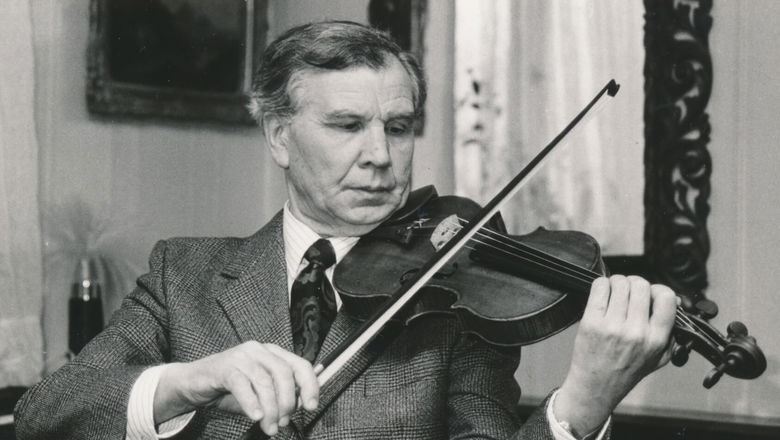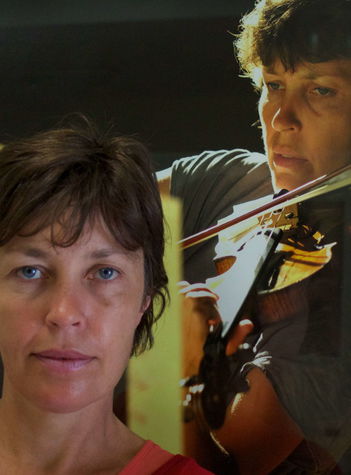1 / 6
Czech Chamber Music Society • Concert for the 100th Anniversary of the Birth of Jiří Novák
Programme
Niccolò Paganini
Concerto for Violin and Orchestra No. 1 in D major, Op. 6 (18')
Recorded by Jiří Novák with the Prague Symphony Orchestra FOK, conducted by Václav Smetáček, Supraphon 1955
Bedřich Smetana
String Quartet No. 1 in E minor “From My Life” (28')
— Intermission —
Excerpt from the documentary film "Smetanovci", directed by Jaromil Jireš, 1998 (15')
Wolfgang Amadeus Mozart
Violin Concerto in D major, K 218 (26')
Performers
Hana Kotková violin
Wihan Quartet
Chamber Orchestra of the Pupils and Friends of Jiří Novák
Jitka Novotná host

Customer Service of Czech Philharmonic
Tel.: +420 227 059 227
E-mail: info@czechphilharmonic.cz
Customer service is available on weekdays from 9 a.m. to 6 p.m.
Performers
Hana Kotková violin

Wihan Quartet

Leoš Čepický (violin), Jan Schulmeister (violin), Jakub Čepický (viola), Michal Kaňka (violoncello)
The Wihan Quartet, celebrating its fortieth anniversary in 2025, is one of the leading string quartets to emerge from the great Czech school of performance in recent years. Praised by the New York Times for possessing a sound that is “deeply pleasurable and also deeply traditional” and called “one of the world’s finest chamber ensembles” by BBC Music Magazine, the quartet has gained an extraordinary reputation for its interpretation of the Czech domestic repertoire and beyond.
The quartet perform regularly in the Czech Republic and the United Kingdom, and previous seasons have included tours and appearances at major festivals throughout Europe, the United States, East Asia and Australia. Winners of the First Prize and the Audience Prize in the 1991 London International String Quartet Competition, the quartet is a laureate of many international competitions, including the Prague Spring Festival and Osaka Chamber Festa. Past career highlights include a period as the Czech Chamber Music Society Resident Ensemble at the Rudolfinum Dvorak Hall, Prague, and their years as Richard Carne Quartet in Residence at Trinity Laban Conservatoire of Music and Dance.
The Wihan Quartet is respected for its world-class recordings and has been described by International Record Review as ‘one of the best quartets in the world today’. With over twenty-five recordings to their credit, the quartet has received international critical acclaim. Their recent Smetana and Dvořák recording has been awarded 5 stars from BBC Music Magazine, while their 2020 collaboration with pianist Mimi Shikimori of Franck and Fauré quintets was hailed by the Sunday Times as a ‘deeply satisfying disc’.
Founder members Leoš Čepický and Jan Schulmeister were joined by violist Jakub Čepický in 2014 and cellist Michal Kaňka the following year, succeeding original members Jiří Žigmund and Aleš Kaspřík.
Komorní orchestr žáků a přátel Jiřího Nováka
Jitka Novotná
Compositions
Bedřich Smetana
String Quartet No. 1 in E minor “From My Life”
String Quartet No. 1 in E minor, subtitled “From My Life”, was composed by Bedřich Smetana at the end of 1876, two years after he lost his hearing. As the subtitle of the work suggests, it has autobiographical features and is considered to be the composer’s confession of a lifetime and artistic statement. Smetana’s Piano Trio in G minor, Op. 15 from 1855, composed after the death of his first-born daughter Bedřiška, also had an intimate subtext. Smetana was inherently a programmatic composer and dramatist, and these qualities gave shape to his first string quartet. It was to be premiered on 19 February 1877 by the Bennewitz Quartet. However, its members found the piece too symphonic and refused to perform it. The public premiere took place as late as 29 March 1879 at a concert of the Art Society, performed by Ferdinand Lachner, Jan Pelikán, Josef Kerhan and Alois Neruda. Before that, however, the composer’s friend Josef Srb-Debrnov, who organized musical afternoons in his apartment, presented Smetana’s quartet to a closer circle of listeners in mid-April 1878. Smetana wrote to Srb on that occasion: “As regards my Quartet, I gladly leave others to judge its style, and I shall not be in the least angry if this style does not find favor or is considered contrary to what was hitherto regarded as quartet style. I did not intend to write a quartet according to recipe or custom in the usual forms. As a young beginner I worked sufficiently hard to acquire thorough knowledge and mastery of musical theory. [...] For me the form of every composition is dictated by the subject itself.” The established forms served Smetana as a starting point and he transformed their laws to suit his needs.
The work is indisputably autobiographical, and the composer himself made it known. The first movement expresses his youthful leanings toward art, a romantic atmosphere and “the inexpressible yearning for something I could neither express nor define, and also a kind of warning of my future misfortune.” The polka of the second movement is a reminiscence of the joyful days of Smetana’s youth; its middle section, he writes, is “the one which, in the opinion of the gentlemen who play this quartet, is unperformable. The purity of the chords is said to be impossible to achieve; I remind myself that I am painting in the tones of this movement my recollections of the aristocratic circles in which I lived for many years.” The third movement “brings to mind the happiness of my first love for the girl who later on became my faithful wife,” i.e., for Kateřina Kolářová. In the final movement, Smetana describes “discovery of how to make use of the elements of national music, joy at the success of this course up to the time it was interrupted by the catastrophe of the onset of my deafness,” as announced by a piercing high E fatefully ringing in his ears. “Roughly this is the aim of this composition, an almost private one, and therefore purposely written for four instruments which talk to each other in an intimate circle of friends of what has so momentously affected me.”
Wolfgang Amadeus Mozart
Violin Concerto in D major, K 218